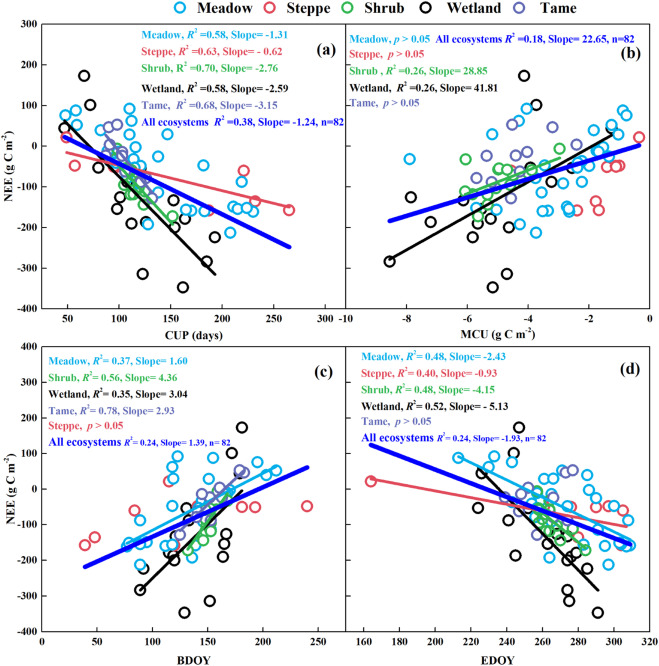The Qinghai-Xizang Plateau (QZP) alpine ecosystem serves as a critical carbon (C) sink, with its seasonal and interannual variation in C assimilation capacity regulated by climatic factors. The C sequestration process in alpine grasslands on the QZP can be divided into the C uptake period (CUP) and the C emission period. However, the relative contributions of these periods to the interannual variability of net ecosystem exchange (NEE) remain unclear. In this study, we decomposed the annual NEE of QZP alpine ecosystems into phenological and physiological components, focusing on the CUP and the maximum rate of net C uptake (MCU). We analyzed interannual anomalies in seasonal and annual NEE, CUP, and MCU in relation to climatic variables across various alpine ecosystems, including alpine meadows (11 sites), alpine wetlands (seven sites), alpine shrub meadows (two sites), alpine steppes (three sites), and tame grasslands (one site). Our key findings indicate that alpine steppes exhibited the longest CUP but the lowest MCU, whereas tame grasslands had a shorter CUP than natural grasslands. Alpine wetlands demonstrated the highest MCU. Across the 84 site-years studied, we found that NEE was predominantly influenced by CUP, which accounted for 38 % of its variability, whereas MCU explained 18 %. The beginning date of the CUP (BDOY) in natural grasslands was primarily driven by spring precipitation. Summer water availability negatively affected MCU in natural grasslands but had a positive effect in tame grasslands. In contrast, human management practices (e.g., sowing and harvesting) determined the CUP of tame grasslands and, consequently, their interannual NEE variability. Winter ecosystem respiration (RE), which accounted for 15 % of annual RE, was largely controlled by snowfall and net radiation. The length of the CUP was determined by early-season precipitation and grassland type, contributing to interannual NEE variability and ecosystem differences.

Fig. 4. (a) The changes in annual net ecosystem exchange (NEE) with the net carbon uptake period (CUP), (b) the maximum rates of net carbon uptake (MCU), (c) net carbon uptake beginning day (BDOY) and (d) net carbon uptake ending day (EDOY) in alpine meadow, alpine shrub, alpine wetland, alpine steppe and tame ecosystems.
The link below will guide you to the reading:
https://www.sciencedirect.com/science/article/pii/S016819232500276X?dgcid=author#tbl0002
